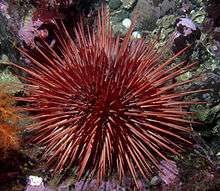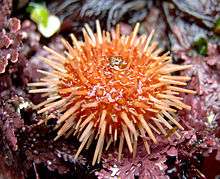Red sea urchin
The red sea urchin (Mesocentrotus franciscanus)[1] is a sea urchin found in the northeastern Pacific Ocean from Alaska to Baja California. It lives in shallow waters from the low-tide line to greater than 100 m (330 ft) deep,[2] and is typically found on rocky shores sheltered from extreme wave action.
| Red sea urchin | |
|---|---|
 | |
| Scientific classification | |
| Kingdom: | |
| Phylum: | |
| Class: | |
| Order: | |
| Family: | |
| Genus: | Mesocentrotus |
| Species: | S. franciscanus |
| Binomial name | |
| Mesocentrotus franciscanus (Aggasiz, 1863) | |
| Synonyms | |
| |
Description

A sea urchin's spherical body is completely covered by sharp spines. These spines grow on a hard shell called the "test", which encloses the animal. It can vary in color from red to dark burgundy. Rarely, albino specimens are found. It has a mouth located on its underside, which is surrounded by five teeth. During larval development, the body of a sea urchin transitions from bilateral to radial symmetry.
This bilaterally symmetrical larva, called an echinopluteus, subsequently develops a type of pentaradiate symmetry that characterises echinoderms. It crawls very slowly over the sea bottom using its spines as stilts, with the help of its tube feet. Scattered among its spines are rows of tiny tube feet with suckers that help it to move and stick to the sea floor.
Feeding habits
This animal has a mouth with special jaws (Aristotle's lantern) located on the bottom (oral) surface. Its preferred diet is seaweeds and algae, which it scrapes off and tears up from the sea floor. During larval development, urchins use bands of cilia to capture food from the water column.[3] Red sea urchins found in the channel adjacent to San Juan Island have been found to live a uniquely sedentary lifestyle with the heavy currents bringing an abundance of food.[4][5]
Behavior and reproduction
Sea urchins are often found living in clumps from five to ten. They have the ability to regenerate lost spines. Lifespan often exceeds 30 years, and scientists have found some specimens to be over 200 years old.[6] Red sea urchins are notoriously ravenous kelp-eaters and are implicated in devastating kelp beds[7] by forming grazing fronts. The intense grazing pressure exerted by urchins is an important link in a trophic cascade often observed along the west coast of North America in which sea otter predation influences urchin abundance, which in turn influences kelp devastation.[8] In contrast to their negatively perceived impact on community structure in open coastal kelp beds, the sedentary behavior and capture of detrital seaweed in the San Juan Islands is hypothesized to create an important habitat and energy source below the photic zone.[4] These diverse ecosystem effects of red urchins highlight their importance as ecosystem engineers in temperate rocky reef ecosystems.
Spawning peaks between June and September. Eggs are fertilized externally while they float in the ocean, and planktonic larvae remain in the water column for about a month before settling on the bottom of the sea floor, where they undergo metamorphosis into juvenile urchins. These juveniles use chemical cues to locate adults.[9] Although juveniles are found almost exclusively under aggregated adults, the adults and juveniles are not directly related.[10]
References
- Agassiz, A. "Strongylocentrotus franciscanus". WoRMS. Retrieved 27 April 2020.
- Britton-Simmons, Kevin; et al. (2012). "Habitat and bathymetry influence the landscape-scale distribution and abundance of drift macrophytes and associated invertebrates". Limnology and Oceanography. 57: 176–184. doi:10.4319/lo.2012.57.1.0176. Archived from the original on 2015-11-14.
- Richard R. Strathmann (1971). "The feeding behavior of planktotrophic echinoderm larvae: mechanisms, regulation, and rates of suspension feeding". Journal of Experimental Marine Biology and Ecology. 6 (2): 109–160. doi:10.1016/0022-0981(71)90054-2.
- Lowe, Alexander; et al. (2015). "Sedentary urchins influence benthic community composition below the macroalgal zone". Marine Ecology. 36 (2): 129–140. doi:10.1111/maec.12124.
- Whippo, R; Lowe, A; Britton-Simmons, K (2011). "Effects of the Red Sea Urchin on Benthic Invertebrate Communities: A Link to Spatial Subsidies". In: Pollock NW, Ed. Diving for Science 2011. Proceedings of the American Academy of Underwater Sciences 30th Symposium. Dauphin Island, AL: AAUS; 2011. Retrieved 2013-03-18.
- Thomas A. Ebert & John R. Southon (2003). "Red sea urchins (Strongylocentrotus franciscanus) can live over 100 years: confirmation with A-bomb 14carbon" (PDF). Fishery Bulletin. 101 (4): 915–922.
- Harrold and Reed (1985). "Food availability, sea urchin grazing, and kelp forest community structure". Ecology. 66 (4): 1160–1169. doi:10.2307/1939168. JSTOR 1939168.
- Estes and Duggins (1995). "Sea otters and kelp forests in Alaska: generality and variation in a community ecological paradigm". Ecological Monographs. 65 (1): 75–100. doi:10.2307/2937159. JSTOR 2937159.
- Nishizaki, Michael T; Ackerman, JD (2000). "A secondary chemical cue facilitates juvenile‐adult postsettlement associations in red sea urchins". Limnology & Oceanography. 50 (1): 354–362. doi:10.4319/lo.2005.50.1.0354.
- Moberg, PE; Burton, Ronald (2000). "Genetic heterogeneity among adult and recruit red sea urchins, Strongylocentrotus franciscanus". Marine Biology. 136 (5): 773–784. doi:10.1007/s002270000281.
External links
| Wikimedia Commons has media related to Strongylocentrotus franciscanus. |
| Wikispecies has information related to Strongylocentrotus franciscanus |
- The sea urchin genome project
- Pacific Urchin Harvesters Association
- Photos of Red sea urchin on Sealife Collection